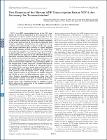| dc.contributor.author | MURPHY, PAULA | |
| dc.date.accessioned | 2009-11-18T15:51:45Z | |
| dc.date.available | 2009-11-18T15:51:45Z | |
| dc.date.issued | 2001 | |
| dc.date.submitted | 2001 | en |
| dc.identifier.citation | Husberg, C., Murphy, P., Martin, E. and Kolsto, A.B. `Two domains of the human bZIP transcription factor TCF11 are necessary for transactivation? in Journal of Biological Chemistry, 276, (21), 2001, pp 17641 - 17652 | en |
| dc.identifier.other | Y | |
| dc.identifier.other | Y | en |
| dc.identifier.uri | http://hdl.handle.net/2262/34766 | |
| dc.description | PUBLISHED | en |
| dc.description.sponsorship | TCF11 is a bZIP transcription factor of the CNC subfamily. It has been implicated in the regulation of the antioxidant response and is vital during embryonic development, but its precise biological functions have not yet been fully worked out. Structural characterization of the gene and several of its products indicates that complex regulatory mechanisms are employed. To investigate how altering the structure of the gene products might influence their activity we have mapped functional domains within the protein. We show that two separate domains are required for transactivation by full-length TCF11: an N-terminal acidic domain and a serine-rich stretch adjacent to the CNC-bZIP domains. A naturally occurring shorter isoform (identical to LCR-F1) produced by internal initiation of translation is unable to transactivate in our assay. However, the shorter form could interfere with the transactivating ability of the longer form, which indicates a control mechanism for keeping the activity of TCF11 at a desired level. We show that TCF11 and the closely related CNC-bZIP factor p45 NF-E2 show different cell type-specific activation patterns with full-length TCF11 being active in COS-1 cells but silent in erythroid cells (K562), whereas p45 NF-E2 is active in K562 cells and silent in COS-1 cells. Domain swapping experiments show that cell type-specific activity is not fully determined by dimerization/DNA binding domains or transactivation domains alone. The resulting profile of activity is most likely achieved by interaction of the domains and their cell-specific environment. | en |
| dc.format.extent | 17641 | en |
| dc.format.extent | 17652 | en |
| dc.format.extent | 635402 bytes | |
| dc.format.mimetype | application/pdf | |
| dc.language.iso | en | en |
| dc.publisher | American Society for Biochemistry and Molecular Biology | en |
| dc.relation.ispartofseries | Journal of Biological Chemistry | en |
| dc.relation.ispartofseries | 276 | en |
| dc.relation.ispartofseries | 21 | en |
| dc.rights | Y | en |
| dc.subject | Zoology | en |
| dc.title | Two domains of the human bZIP transcription factor TCF11 are necessary for transactivation | en |
| dc.type | Journal Article | en |
| dc.type.supercollection | scholarly_publications | en |
| dc.type.supercollection | refereed_publications | en |
| dc.identifier.peoplefinderurl | http://people.tcd.ie/pmurphy3 | |
| dc.identifier.rssinternalid | 1988 | |
| dc.identifier.rssuri | http://dx.doi.org/10.1074/jbc.M007951200 | |




